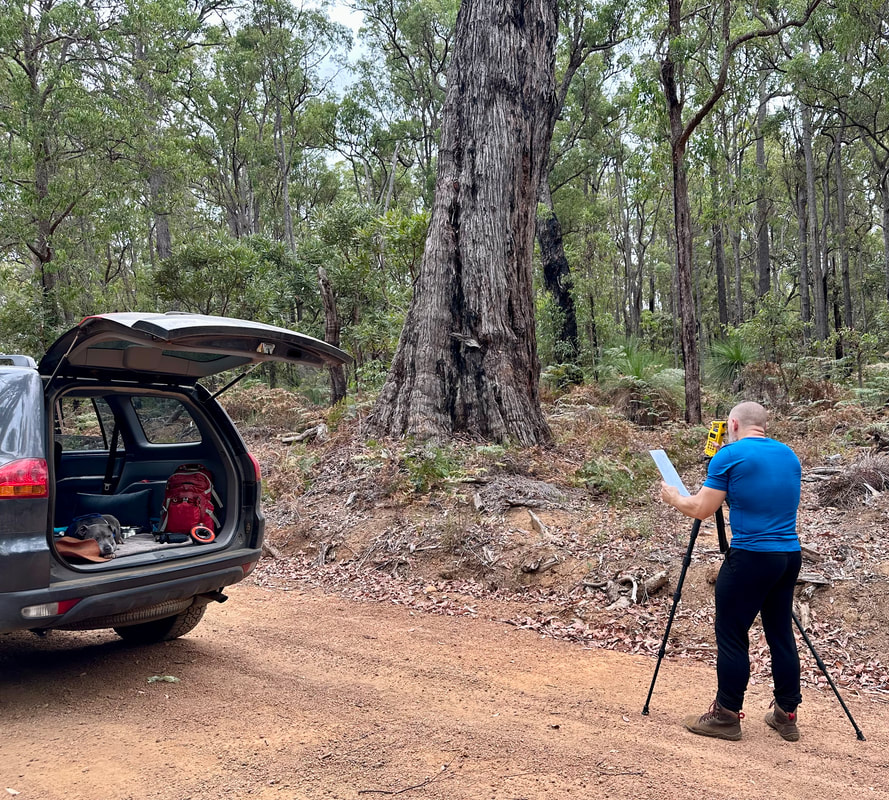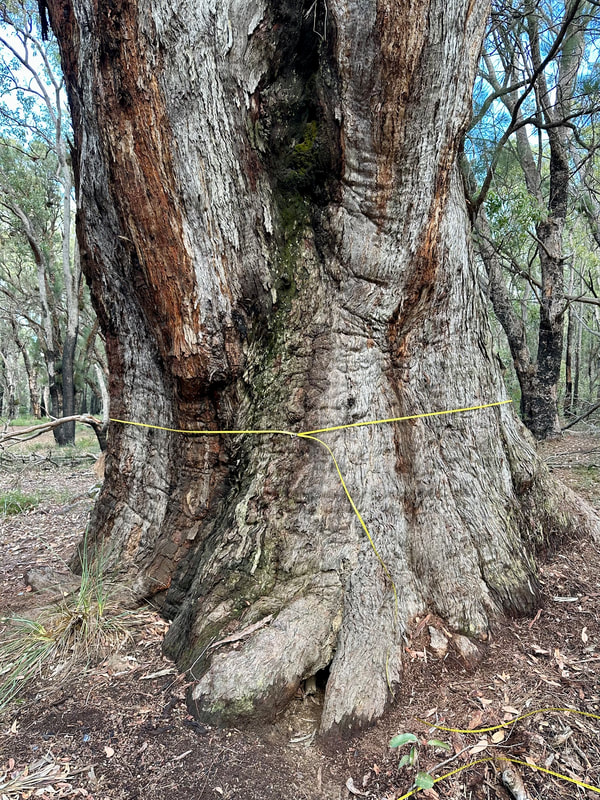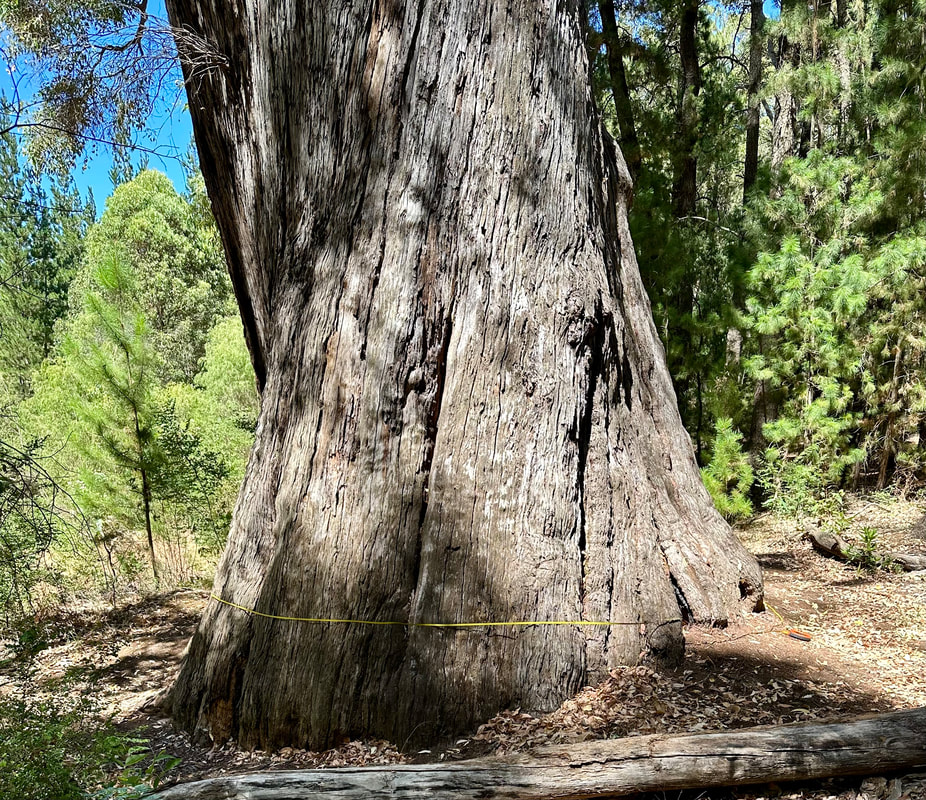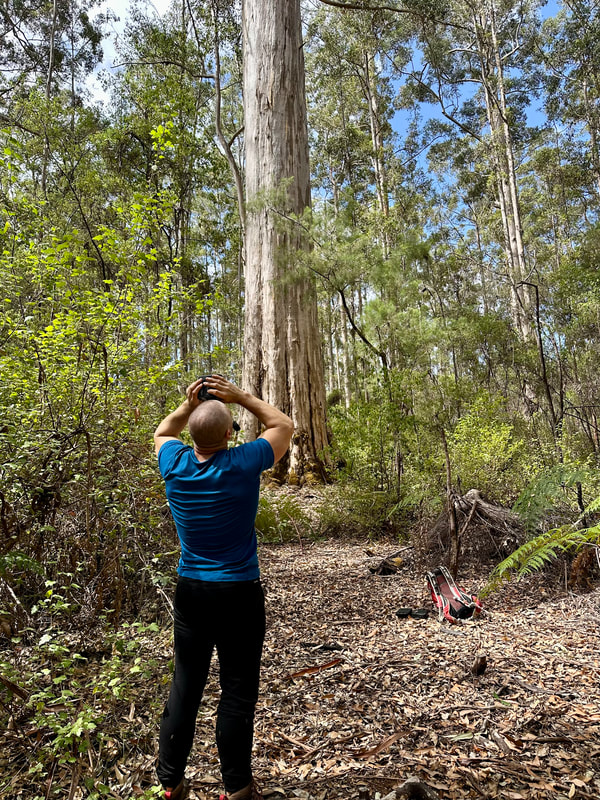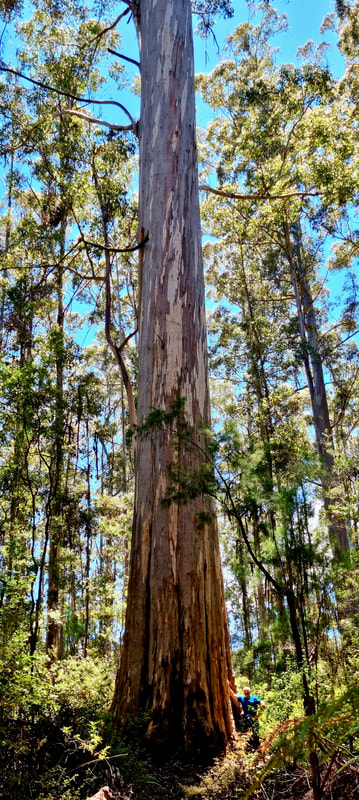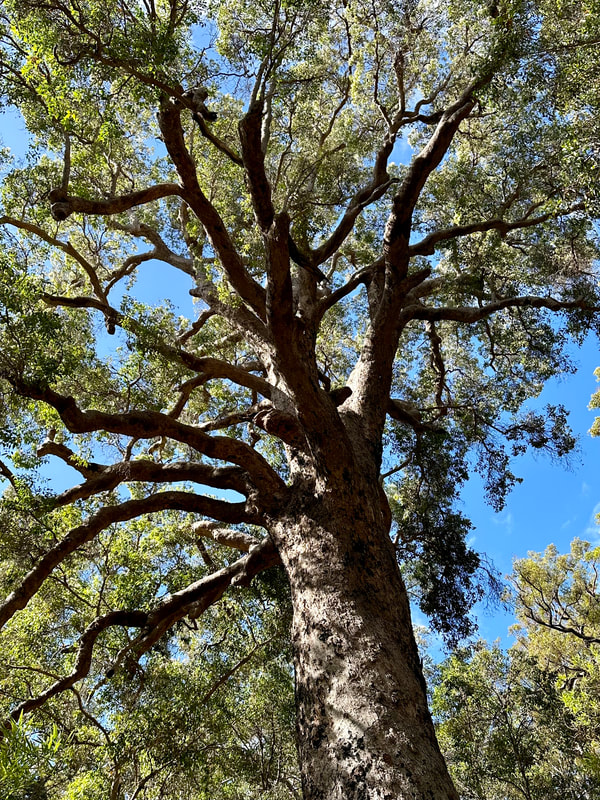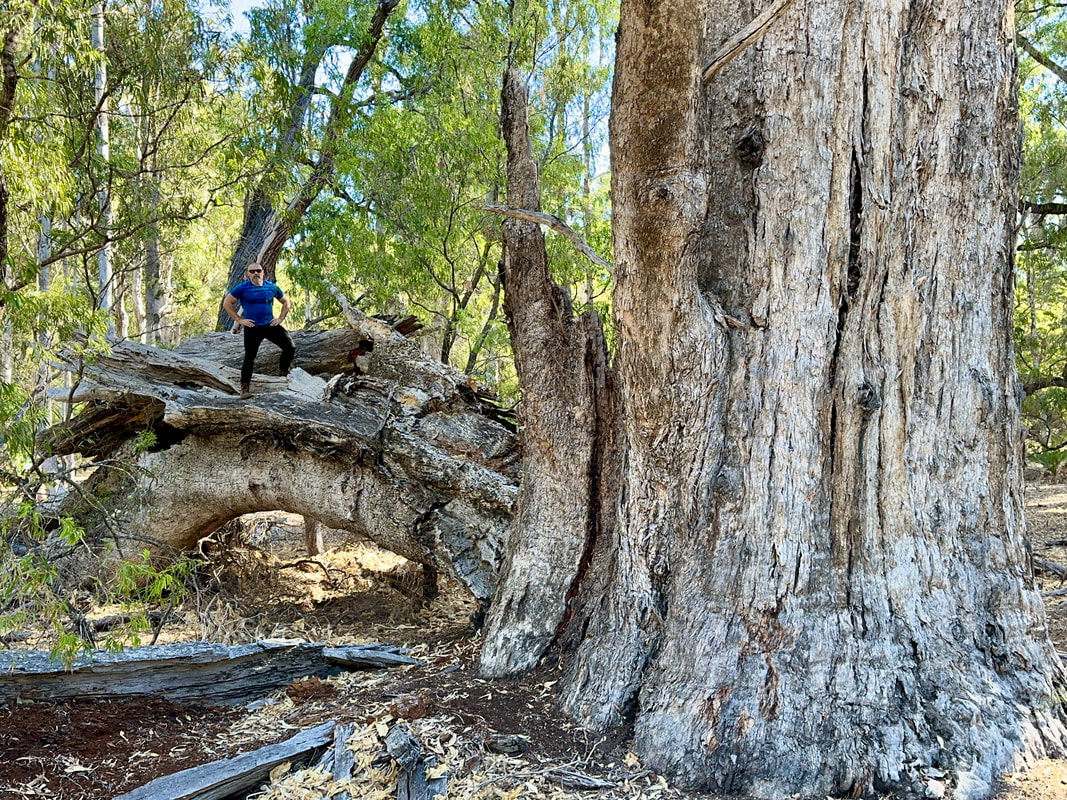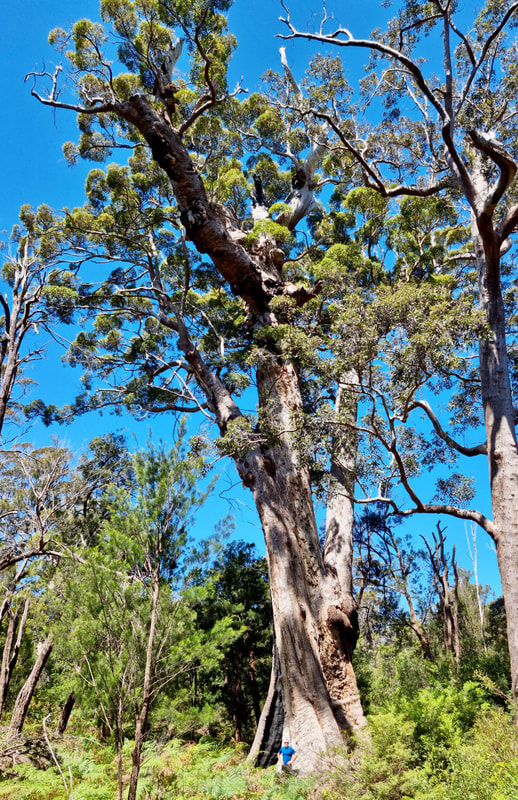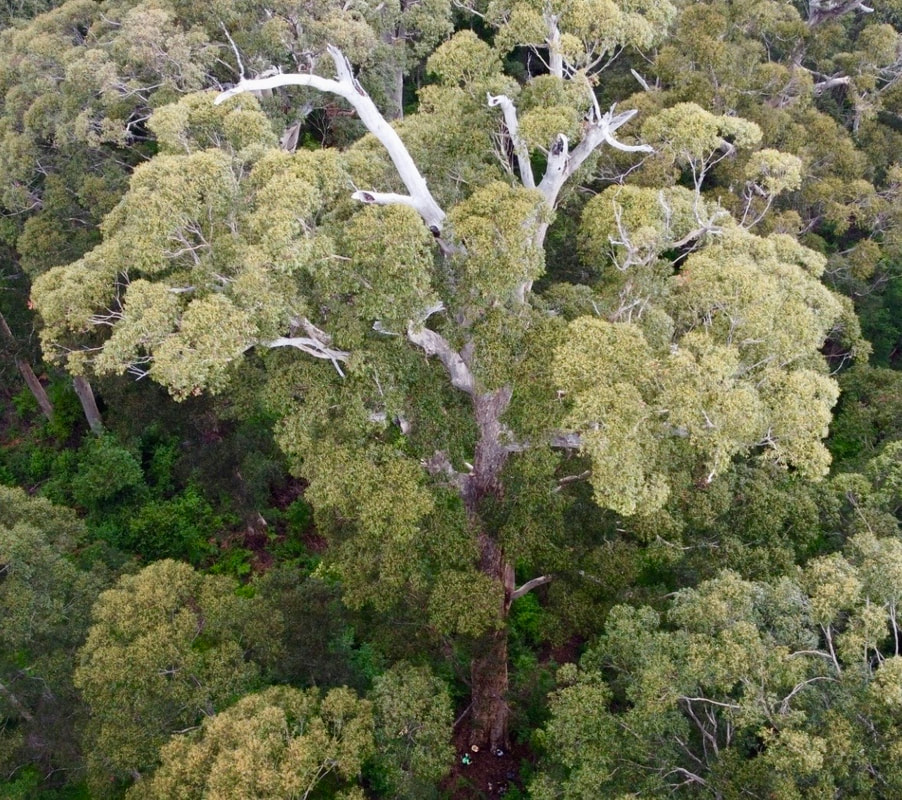How tree measurements are calculated
Diameter at breast height (DBH) is a common measure to compare tree width near the base. Diameter (D), is calculated from circumference divided by π. Breast height (BH) is determined by finding zero ground (ZG) at the base of a tree, then measuring vertically to 1.4 m. This is where a measuring tape is placed horizontally around the trunk to obtain circumference. I have called this circumference at breast height (CBH). These are easy acronyms to familiarise with, which I use a lot in the gallery section as I'm limited for caption space. I include DBH but it's only one of many measures that add up to determine a trees volume. It's what's above that point that counts! It's used as part of the American Forest points system developed as an easy way to compare tree size without measuring its volume. Height and average crown spread are the other measures used in this calculation. Check out the National Register of Big Trees to see the point champions of Australia, I've nominated several from WA. If we look at the American Forest guidelines, they say zero ground begins where the tree began life as a sapling. On all the trees I've measured, zero ground (ZG) was a relatively straight forward assessment. I've determined zero ground (ZG) at the lowest part of the base of a tree where you can wrap a tape around horizontally, slightly different from AF guidelines but easier for my calculations. When a tree isn't level and slopes, any part of the slope below zero ground I call below zero ground (BZG) and calculate its imagined full circumference. I then divide that by half to get an accurate volume even on a slope. On steep slopes this can be very challenging but in WA I haven't really come across very steep slopes. The biggest challenge I have found has been trying to find zero ground under all of the tree's plant litter debris, also known as duff. This has been particularly challenging for giant karri as unlike the soft duff surrounding red tingle, karri have many hard sticks interlocking together around the base, which is impossible to move!
Height is also a common measure to compare trees. I've found over the years that many people associate great height with great size but this is actually a poor correlation. For a given species younger, healthy trees are taller than older weathered specimens which are shorter but much bigger in volume. I'm not too concerned with height for the above reasons but it's still an interesting figure to know and often the first question people ask me about a certain tree. Many tree heights are exaggerated from visual estimations and incorrectly obtained from instruments. Some older measurements like clinometers and newer hypsometers can be accurate if a multitude of factors are perfect, which rarely are in a forest setting. Even lasers are inaccurate with inexperienced users. I myself for nearly a year used tangent method instead of the more accurate sine method for my tree heights. New hypsometers use tangent method and are considered accurate, only if the trunk is straight and the tree doesn't lean, usually ok for pines but not eucalypts. Whenever a friend accompanies me to the forest I always get them to measure the targeted tree first with my laser on sine method, to show them even with the most accurate device, height is still tricky. No ones ever got it right first time, it often takes multiple tries. I then mention 'are we at level ground and have you accounted for your own height?' My eye level where I measure is exactly 1.5 m above the ground which makes it easier to add to a trees height, then I check my elevation to the base of the tree and add up the data. This is how I determine accurate height and even then it's not always possible to see the entire tree base to crown so incremental measures may be needed. I have not really had this problem in WA, but I can imagine in Tasmania or California this would happen on steep slopes and thick forest. I got 99 m for Centurion in Tasmania in 2019 standing at its base finding tiny leaves at the top. Brett was shocked as we added 1.5 m measuring height for a total of 100.5 m! If I'm on a slope (above or below level ground), I can still measure slope height with my laser and add or subtract that slope height for a final total. I don't need to add my own 1.5 m measuring height as I'm not at ground level anymore. All heights were measured by myself using my Laser Technology TruPulse® 360R laser, a highly accurate device but I've rounded to the nearest metre. Many trees have lost a few metres in the years since I took my first readings but I've kept these 'original' heights in the data unless a significant loss occurs.
Trunk Volume is the amount of wood in the trunk. I judge the trunk as the main stem of the tree leaving the ground. I have not have the issue of multiple trunks near the base in WA. Some trunks split evenly further up which are often considered twin trunks and are considered part of the main trunk. In this instance I have included twin trunks as part of trunk volume, such as in the Channybearup Karri. Trunk volume is measured in cubic metres, expressed as m³ in the data. A large city park tree could be around 20 m³ in volume and there would be few planted park trees over 50 m³ around the world. A few giant sequoias planted in Europe over 150 years ago have now reached 100 m³ in trunk volume. The largest WA trees can reach 200 m³ in trunk volume. The largest giant sequoias exceed 1000 m³ in trunk volume! Whilst this is a big difference the two biggest WA species would be around the top 15 biggest tree species on earth and around the fifth biggest in Australia. Only the coast redwood (Sequoia sempervirens) and giant sequoia (Sequoidendron giganteum) species exceed 500 m³ in trunk volume.
Before I begin measuring a tree, I have to select an ideal vantage point to measure from, to view as much of the whole tree as I can see. Sometimes I may need to select another view to see parts I can’t quite see clearly enough in my first spot. I've done this for a number of trees, volume data is then averaged. I've measured Old Rusty and The Tyrant from four different positions! I then set up my equipment. I then do a rough technical sketch of my view on an A4 notepad. I also photograph the tree from this position so I can refer back to check I haven’t missed anything. I can then begin to record and write down these measurements on the notepad, reflecting the data points on the tree to match my sketch. From practise I have learnt to organise my data on the page in exactly the same way so it makes sense to me!
I measure the main trunk using a Laser Technology Criterion™ RD1000 dendrometer (tree measuring device), specifically designed for this task. I use my sturdy Vanguard® tripod to secure the device which has a universal joint allowing me to access vertical and horizontal angles. The Criterion™ RD1000 has a viewfinder with lasers which project onto the tree and you line up the tree width with the lasers using a toggle switch. When aligned you trigger the switch and get a width or reading in the selected units, imperial or metric. I take readings at every metre for the first few metres, then every five metres and at trunk taperings which often occur when large limbs emerge. For Hollow Trunk I did readings every metre, just to be sure! I can then divide up the trunk in cylinders, calculate each cylinders volume then add up each cylinder to give me total trunk volume. This takes around hour and as can be seen in the data, trunk volume represents most of the entire tree volume. I can check the height displayed on the Criterion™ RD1000 with my TruPulse® 360R laser to make sure the readings are accurate. The tripod and dendrometer are always fixed together or the readings are not accurate. Also, almost all the base images are set on ten second timer on my camera or smartphone on a device attached to my tripod and off I run, carefully! Hollows caused by rot or fire on the main trunk can be included or restored in the official data, such as in Hollow Trunk. This has been standard practise for decades so I have done the same although some caution should be used when comparing restored and actual volume. I explore more on this subject in the red tingle section.
Before I begin measuring a tree, I have to select an ideal vantage point to measure from, to view as much of the whole tree as I can see. Sometimes I may need to select another view to see parts I can’t quite see clearly enough in my first spot. I've done this for a number of trees, volume data is then averaged. I've measured Old Rusty and The Tyrant from four different positions! I then set up my equipment. I then do a rough technical sketch of my view on an A4 notepad. I also photograph the tree from this position so I can refer back to check I haven’t missed anything. I can then begin to record and write down these measurements on the notepad, reflecting the data points on the tree to match my sketch. From practise I have learnt to organise my data on the page in exactly the same way so it makes sense to me!
I measure the main trunk using a Laser Technology Criterion™ RD1000 dendrometer (tree measuring device), specifically designed for this task. I use my sturdy Vanguard® tripod to secure the device which has a universal joint allowing me to access vertical and horizontal angles. The Criterion™ RD1000 has a viewfinder with lasers which project onto the tree and you line up the tree width with the lasers using a toggle switch. When aligned you trigger the switch and get a width or reading in the selected units, imperial or metric. I take readings at every metre for the first few metres, then every five metres and at trunk taperings which often occur when large limbs emerge. For Hollow Trunk I did readings every metre, just to be sure! I can then divide up the trunk in cylinders, calculate each cylinders volume then add up each cylinder to give me total trunk volume. This takes around hour and as can be seen in the data, trunk volume represents most of the entire tree volume. I can check the height displayed on the Criterion™ RD1000 with my TruPulse® 360R laser to make sure the readings are accurate. The tripod and dendrometer are always fixed together or the readings are not accurate. Also, almost all the base images are set on ten second timer on my camera or smartphone on a device attached to my tripod and off I run, carefully! Hollows caused by rot or fire on the main trunk can be included or restored in the official data, such as in Hollow Trunk. This has been standard practise for decades so I have done the same although some caution should be used when comparing restored and actual volume. I explore more on this subject in the red tingle section.
Limb Volume is all the remaining limbs I can accurately measure. As a guide if a limb looks significant (greater than 30 cm in diameter) I'll measure it using my equipment mentioned. If it's insignificant, (less than 30 cm in diameter) I have a section in my data called 'other' which includes small limbs, burls, bumps or irregularities. I estimate the total of all these 'other' and add that to my final calculation. In reality 'other' represents a tiny percentage of total volume, always less than one percent.
To measure limb volume I use the same techniques mentioned above but use my laser to assist for more accurate horizontal and incline limb measurements. I label each limb I measure as A, B, C, D, etc so there’s less numbers on the page to confuse me. Limb volume is very time consuming and is rarely calculated in tree volume. It can take up to another hour to measure and I may have to move the machine to several locations to see all the limbs. In fact standard practise is not to include limb volume in tree volume calculations due to the difficulty involved! Most giant trees measured are conifers with a very high percentage of trunk to limb volume ratio, usually well over 90 % of the total volume is trunk. Only a few researchers around the world have measured the largest limbs and trunk volume on some trees, which would represent up to 95 % of the total volume. Some big tree hunters have measured 100 % of total wood volume in a few trees around the world. This may take days with several people involved, usually climbing the tree on ropes with tapes! I have tried to include 100 % of total wood volume too. Hopefully others will follow suit. As can be seen in the data all six WA giant trees have an interesting and non uniform percentage of trunk to limb volume ratio.
To measure limb volume I use the same techniques mentioned above but use my laser to assist for more accurate horizontal and incline limb measurements. I label each limb I measure as A, B, C, D, etc so there’s less numbers on the page to confuse me. Limb volume is very time consuming and is rarely calculated in tree volume. It can take up to another hour to measure and I may have to move the machine to several locations to see all the limbs. In fact standard practise is not to include limb volume in tree volume calculations due to the difficulty involved! Most giant trees measured are conifers with a very high percentage of trunk to limb volume ratio, usually well over 90 % of the total volume is trunk. Only a few researchers around the world have measured the largest limbs and trunk volume on some trees, which would represent up to 95 % of the total volume. Some big tree hunters have measured 100 % of total wood volume in a few trees around the world. This may take days with several people involved, usually climbing the tree on ropes with tapes! I have tried to include 100 % of total wood volume too. Hopefully others will follow suit. As can be seen in the data all six WA giant trees have an interesting and non uniform percentage of trunk to limb volume ratio.
Missing Volume is an estimation by myself of what has been lost in the past. It includes trunk and limbs. An example of missing trunk volume I've found is the Hulk marri, which has an exceptional base. The main trunk breaks at 22 m where the diameter is 1.15 m. A plaque hammered on the trunk indicates years earlier this tree was 47 m. It is currently 34 m with several large intact limbs reaching to that height. It seems likely that a large section of upper trunk broke off years ago. I estimate this volume Loss at around 10 m³ based on the diameter at 22 m.
Another example but of missing limbs is found in Lone Yarri. At 10 metres the trunk suddenly tapers 50 cm in diameter for no apparent reason. This is rare but I surmise the reason was a huge limb broke off and the tree eventually recovered growing bark fully over the affected area. I estimate the limb lost at at least 10 m³ but this is purely speculation. The Hulk marri and Lone Yarri have no evidence of their lost trunk and limbs, however it's likely these rotted away or burnt many decades ago.
When there's clear evidence of missing limbs or trunk lying on the ground I have decided to include it in the data, if I can measure it accurately. An example of this is the Smashed Giant, a huge tuart. Part of its trunk and most of its limbs have collapsed but are clearly visible next to it. I managed to accurately measure most of the fallen wood so have included it in the official data. Also the Wonnerup Tuart has lost some huge limbs since I originally measured it. In this instance I have kept my original figures, which I think is reasonable.
As stated earlier, this section is purely as an interest section for the reader, an estimation by myself of what has likely been lost in the past. It is included in the data, but not as part of the actual volume of the tree.
Another example but of missing limbs is found in Lone Yarri. At 10 metres the trunk suddenly tapers 50 cm in diameter for no apparent reason. This is rare but I surmise the reason was a huge limb broke off and the tree eventually recovered growing bark fully over the affected area. I estimate the limb lost at at least 10 m³ but this is purely speculation. The Hulk marri and Lone Yarri have no evidence of their lost trunk and limbs, however it's likely these rotted away or burnt many decades ago.
When there's clear evidence of missing limbs or trunk lying on the ground I have decided to include it in the data, if I can measure it accurately. An example of this is the Smashed Giant, a huge tuart. Part of its trunk and most of its limbs have collapsed but are clearly visible next to it. I managed to accurately measure most of the fallen wood so have included it in the official data. Also the Wonnerup Tuart has lost some huge limbs since I originally measured it. In this instance I have kept my original figures, which I think is reasonable.
As stated earlier, this section is purely as an interest section for the reader, an estimation by myself of what has likely been lost in the past. It is included in the data, but not as part of the actual volume of the tree.
Total Volume is the addition of trunk and limb volume, they should add up. 'Other' volume I've mentioned earlier is included in limb volume. I don't include Missing Volume as stated earlier as it is too speculative and no longer part of the living tree. However I list it as I feel it is interesting to imagine 'what might have been' and shows the reader past events in a trees long life. Some trees have fallen limbs or part of the trunk lying on the ground, such as the Smashed Giant. I have included this volume in special cases when it is clear that this used to part of the tree, as previously mentioned. I feel total wood volume is the best way to fully represent the volume of a tree. I haven't included roots which would fully represent total volume, or leaves (which wouldn't be much) simply as I can't accurately measure them! If I had to guess, I would estimate roots may account for less than 5% of trunk volume with some species having more or less than others. In my own experience of seeing downed giants in the Southwest, most trees have by the end of their life a surprisingly small amount of roots, barely a tonne. This makes sense though, as the reason many fall over is that their roots and lower trunk have simply rooted away and they have lost the support needed to stay upright. Younger trees would have a higher percentage of root volume than older trees making root measurement rather tricky!
Weight is the total amount of wood calculated in tonnes. It comes from the total volume times the tree species green weight density, a figure which represents the living weight per unit of tree species. This unit is expressed as kilograms per cubic metre (kg/m³). Green or wet weight density is called green to represent a living tree, full of moisture. Dry weight density is a more common term referring to dried, prepared timber ready for use. Green weight density is used in the logging industry to calculate how heavy a log might weigh. This is important to prevent equipment damage. It’s not in common usage but is generally found for common trees in technical data. An example of how I calculate tree weight is as follows : The Tyrant 1200 kg/m³ x 224.9 m³ = 269880 kg, or 269.9 tonnes. Weight is not usually included in tree data but I feel it is probably the best metric to compare size amongst other tree species particularly softwoods and hardwoods around the world. An example of what I mean is the living difference between the western red cedar (Thuja plicata) and karri. If both are 100 m³ in volume you would think they would be about the same weight too. The western red cedar would weigh around 60 tonnes but the karri would weigh 120 tonnes, double its weight but the same size! This is why I include weight as I feel volume may not give the full picture. Trees are generally compared to by volume but humans compare size by weight and I’ve done the same I think presenting more meaningful data. The Cheewhat Giant at 449 m³ in volume is the largest western red cedar currently known and the third largest tree species after the two redwood species. Weighing in at around 269 tonnes, it is the same weight as The Tyrant which is much smaller in volume, these Eucalyptus and Corymbia are very dense for their size.
